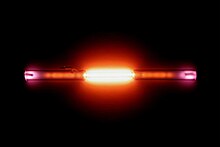Imagine a world where nothing can go wrong, where everything is perfect...perhaps too perfect. A world where scientists are never let down by pesky conditions which disrupt their measurements.
A world, in which there's an ideal gas.
What is an ideal gas?
An ideal gas would be one where all collisions are perfectly elastic, so no energy is lost. This is understandably rather difficult to do - energy is lost all the time during chemical reactions, so for the total energy to remain the same throughout would be an impressive feat. As well as this, there are a few other conditions which need to be obeyed, such as:
-
a lack of intermolecular force interactions with other gas
molecules;
- the molecular volumes are essentially negligible, and;
-
the gas particles move constantly and randomly, in accordance with
Newton's laws of motion.
Those conditions, coupled with the reality of energy transfers, mean that there aren't any ideal gases because none obey all those conditions - that's why the hypothetical gas is ideal (gases that don't obey these conditions are non-ideal).

A detour on the Boltzmann constant (though not entirely unrelated):
During collisions, the energy transferred during collisions would be kinetic, which causes the transfer of thermal energy, so any transfer in kinetic energy would have to be alongside a change in temperature. This can be seen in the equation E=kBT, where kB refers to the Boltzmann constant - about 1.38 x 10-23 J/K - which is also used to define the SI unit Kelvin. Another formula linking energy and temperature is E = (3/2)kBT, which arises as a result of combining the ideal gas equation below with the root mean square speed of a molecule, but that isn't what this blogpost is about. But to put it simply, it comes from the idea a gas molecule can move in three directions, with its average energy being about (1/2)kBT, hence 3/2, but this is meant to be a brief overview and after looking at the proofs, I struggle to understand any of them.
What's important however is the fact that energy is linked to temperature, which explains why at absolute zero, a system has no energy - indeed, absolute zero is defined in relation to the ideal gas. This is also why it's almost impossible you could ever cool an object down to absolute zero - you could try, but I doubt you'd succeed (you can get close to it with the right conditions, though).
The reverse is true - a higher temperature means the system has more energy. But not a phenomenal amount more of energy, because the Boltzmann constant is so small (so adding a joule of energy into a system is equivalent to increasing the system's temperature by a factor of 1.38 x 1023 K). In an ideal gas, the transfer of energy in relation to a system would be constant, yet this isn't the case due to unrelated circumstances.
The ideal gas equations:
There are two - the first is pV = nRT, where p refers to the
pressure, V refers to the volume, n is the quantity of gas in moles, T is
the temperature, and R is the molar gas constant, at about 8.314 J mol-1 K-1
- this is equivalent to Avogadro's number multiplied by the Boltzmann
constant. This equation is
actually a derivation of various laws all put
together (so long as the number of moles is constant): pV
refers to Boyle's
Law, where the pressure is indirectly proportional to the volume; Charles'
Law, where
volume is directly proportional to the temperature (V∝T); Guy-Lussac's Law, where pressure is directly
proportional to the
temperature (P∝T); and Avogadro's Law, where volume is directly proportional to
the
quantity of moles (V∝n). So:
pV = a constant, x, p = k1T, and p = k2n, so pV=(k1k2)nT, and that constant (k1k2) is R.
You can rewrite the equation by using the Boltzmann constant like this, which obtains the second equation:
Since k = R/NA (Avogadro's Number), you can substitute k in, thus
making pV equal to n k NA T. The total number of molecules in a
system can also be expressed as n NA, which is expressed simply as
N. So pV = NkT as well.
To conclude, I'd like to mention the
first fifteen minutes of this lecture
by Walter Lewin which I started watching, which I like because at one point,
he shows something I was taught a few years ago in chemistry, but never truly
considered - that the volume of any gas molecule at room temperature and
pressure is 24 m3 multiplied by the number of gas moles. I think you'll enjoy
that and the rest of the lecture.
I found this blogpost good, but how can I trust you?
Here are the sources I used to write this blogpost:
This Chemguide article helped provide me with information on helium being close to an ideal gas.
This overview on ideal gases helped provide me with a few key conditions about the ideal gas.
The
Wikipedia article
on ideal gases helped me understand how each of the gas laws came together to
form the ideal gas equation. This
citation comes from a textbook
and whilst it's only a Google Books preview, it's still interesting.
This article is on the Boltzmann constant and the equation E = kBT, and goes much further into the topic than I could have ever dreamt of doing.
This Isaac Physics page on ideal gases helped me begin to get my head around the idea of the equation E = (3/2)kBT (unfortunately I've not reached that part of the physics course yet!). This Britannica article helped he sort of get the 3/2 bit as well.
The image of helium is courtesy of Wikipedia.
Comments
Post a Comment